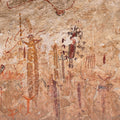Into Old Growth Forest with Photographer Mitch Epstein
By Chadd Scott on
Everything’s connected for photographer Mitch Epstein (b. 1952). In his work, anyway. One thing always leads to the next, typically without premeditation.
That explains how his last series of photographs centering resistance movements across America – “Property Rights” – led him into his most recent series of pictures, “Old Growth,” highlighting America’s old growth forests.
“’Property Rights’ encouraged me to think further about what North America was like pre-colonization,” Epstein said. “That, in part, was instigated by spending time at national monument sites under threat during the Trump administration – we had Ryan Zinke as Interior Secretary. After going to Standing Rock (to shoot for ‘Property Rights’), I went to spend time at Bears Ears and Grand Staircase-Escalante and other sites that got me thinking also about wilderness, and how little wilderness remains, and how important wilderness is to life on Earth.”
Zinke resides in a cult of right wingers who don’t believe in the concept of public property. No National Parks, National Forests, National Wildlife Refuges, etc. He believes only in private property; private property for the exploitation of industry – logging, ranching, fossil fuels – and the super wealthy.
His efforts as Interior Secretary to carry out this aim included major reductions to national monuments, Bears Ears and Grand Staircase-Escalante in southern Utah among them. To say nothing of their scenic beauty, benefit to wildlife, and use for public recommendations, both sites are historically sacred to numerous tribal nations including the Navajo, Zuni, Hopi, Ute, and Ute Mountain Ute. Zinke’s tenure at Interior was defined by putting the interests of industry and private property over those of the public and tribes.
The Biden Administration with Interior Secretary Deb Haaland (Pueblo of Laguna) restored the monuments’ boundaries and protections.

Mitch Epstein, ‘Sitka Spruce (Tree of Life), Olympic National Park, Washington, 2021.’ From the series Old Growth. Archival pigment print, 58 x 72 inches. Edition of 6.
‘The Old Growth Evangelist’
Epstein lives in New York City, hardly the place to connect with nature in open, unpopulated landscapes. As his work on “Property Rights” was finishing up, however, COVID was coming on. Pandemic isolation turned his thoughts to his childhood home in rural western Massachusetts.
“I was doing research about writers I admired and was influenced by from New England – Dickinson, Frost, Melville and so on – thinking it'd be interesting to visit their homesteads, or what's left of where they lived and worked, and what nature was there,” Epstein said.
That lead him to an essay by Bob Leverett, the “old growth evangelist,” detailing the Mohawk Trail State Forest in Epstein’s hometown of Holyoke, MA. Unbelievably, Leverett had found old growth forest there. Ancient trees that had miraculously escaped the colonizers’ saw.
“I thought, that's interesting; let me reach out to him, and he was available,” Epstein remembers.
A month or so later, the two met at the Forest for the first of many walks together.
“That's when the light went on, on that first walk, partly because he was a beautiful man and so expressive, speaking with a Tennessee southern drawl, but with this knowledge that is hard earned through walking the trail and asking questions and studying,” Epstein said. “It encouraged me to get past this barrier I had about stepping into seemingly unadulterated nature.”
Stepping into the genre of wilderness photography as well. What could he possibly add to such a well-worn genre? What he could add was disposing of the notion.
“I don't have any illusions now about the fact that we are at a point where there is no such thing as unadulterated nature, the global impact of climate and the natural world from the way we choose to live our lives,” Epstein said.
He could also add old growth.
Mitch Epstein’s newest series of photographs, “Old Growth,” continues the artist’s career-long exploration of American culture and the nation’s fraught relationship with the natural world. An exhibition of the pictures debuted at Yancey Richardson gallery in New York on September 5 and can be seen through October 19, 2024. An opening reception will be held on September 12, from 6 – 8 pm, with an artist walkthrough at 5:30 pm.
What is an Old Growth Forest?

Mitch Epstein, ‘Maple Glade, Hoh Rain Forest, Olympic National Park, Washington, 2017.’ From the series Old Growth. Archival pigment print, 36 x 45 inches. Edition of 6.
An “old growth” forest is a survivor. A survivor of fire and wind. A survivor of man. An original. Ancient. Sometimes referred to as “virgin.” Not untouched, but undisturbed.
“I couldn't really have defined for you what an old growth forest was (prior to beginning the project), and even if I could have defined it, I don't know that I would have truly understood it because it can be so variable,” Epstein said. “That was part of the thrill for me, there was so much to discover and to learn.”
As with all things forest, Epstein leaned on Leverett.
“His concept of an old growth forest is one that's been unintruded on by human intervention, but also fortunate enough to have not been challenged by some natural occurrence – severe weather,” Epstein said.
Even scientific definitions vary to an extent, but by and large, an old growth forest is one which has evolved from time immemorial into the present without undue alterations from natural disasters or humanity. They are exceedingly rare. Prior to European contact, most of North America was old growth forest. We’ve all heard the folklore tale of how a squirrel could travel from the Atlantic Ocean to the Mississippi River without touching the ground prior to the arrival of Europeans.
Now, less than 5% remains.
Bigleaf maples, eastern white pines, cedars, sequoias, bristlecone pines, bald cypresses.
Due to the size of their trees and the complex ecological systems allowed to develop within them over hundreds and thousands of years, old growth forests have the capacity to filter carbon dioxide out of the air, produce oxygen – clean the air – absorb runoff and mitigate flooding – clean the water – and support wildlife in vast superiority to forests regrown after severe disturbance, logging for instance. As such, old growth forests play an outsized role in combating humanity’s two self-inflicted existential crises: climate change and the extinction crisis.
One old growth sequoia can capture and store more carbon and support more animals than 1,000 nursery trees.
All trees are not created equal. All forests are not created equal. Big old trees are the most important trees. New trees are wonderful, but saving old trees always has greater ecological benefits than planting new ones.
Be wary of people touting only the planting of tiny saplings as the silver bullet to the climate crisis. Oftentimes, they want to take down big, old trees and con people into allowing it by “offsetting” the damage through planting skinny, new ones. Trees take decades, sometimes centuries, to mature. Putting even millions of sticks in the ground doesn’t offset the damage done by felling mighty, ancient trees.
Protecting our mature trees is more important than planting new ones.
“We think in a timeframe that is short relative to a sequoia redwood tree, a bristlecone pine, or Douglas fir,” Epstein said. “It's hard to imagine a bristlecone pine that dates back to B.C., and so that that alone, I think, requires a real stretch of the imagination.”
Photographing Old Growth

Mitch Epstein, ‘Congress Trail, Sequoia National Park, California, 2021.’ From the series Old Growth. Archival pigment print, 45 x 36 inches. Edition of 6.
From 2017 through 2024, Epstein traveled across America, photographing some of the country’s oldest trees. He began on the East Coast, in the Berkshires where he grew up, then headed West. Because colonization followed the same migration pattern, most of the country’s oldest – and largest – trees lie close to the Pacific Ocean: Douglas fir, giant sequoia and coast redwood, bristlecone pine.
“Humbling; and also daunting in terms of the photographic challenge,” Epstein thought when first encountering them. “Finding a great tree doesn’t mean arriving at a great picture, a picture that can in some way expound upon or illuminate that sense of wonder.”
To capture their immense scale, Epstein used a cumbersome, large format, 8x10 camera akin to what the western wilderness photographers of the 19th century would have used.
“I went back to the sequoia coastal redwood sites – in most cases – to the sites I photographed at least twice because it just didn't always happen the first trip,” he said. “At a certain point, I lost the anxiety, I was joyful. (The finished photographs came from) that ability to lose myself in the presence of something that was so much larger than me and enigmatic in ways that were inexhaustible.”
Only one photo in the Yancey Richardson gallery show features a person. Coincidentally.
“In the Sequoia National Forest, I had set up a picture and I was in the midst of photographing a fire burned sequoia tree and somebody just walked into picture,” Epstein explained with a laugh. “That had a kind of existential levity – the bottom half of that tree was struck by lightning and so, in a graphic way, the burn comes forward and he's kind of looking into the abyss of that blackness – with staging things like that, it's a real art; I could spend months on it and still not have that spontaneity.”
Life in the old growth occurs in moments and over millennia.



